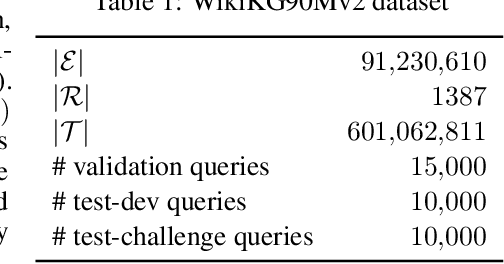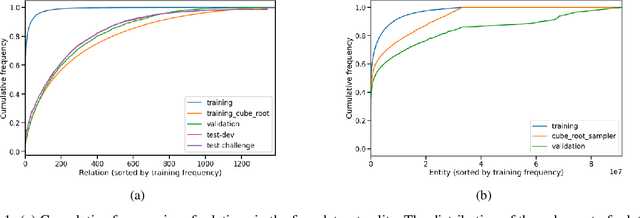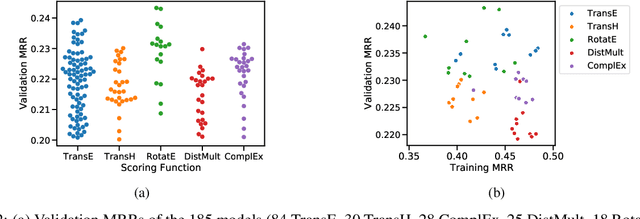Carlo Luschi
Optimal Formats for Weight Quantisation
May 19, 2025Abstract:Weight quantisation is an essential technique for enabling efficient training and deployment of modern deep learning models. However, the recipe book of quantisation formats is large and the formats are often chosen empirically. In this paper, we propose a framework for systematic design and analysis of quantisation formats. By connecting the question of format design with the classical quantisation theory, we show that the strong practical performance of popular formats comes from their ability to represent values using variable-length codes. Framing the optimisation problem as minimising the KL divergence between the original and quantised model outputs, the objective is aligned with minimising the squared quantisation error of the model parameters. We therefore develop and evaluate squared-error-optimal formats for known distributions, observing significant improvement of variable-length codes over fixed-length codes. Uniform quantisation followed by lossless compression with a variable-length code is shown to be optimal. However, we find that commonly used block formats and sparse outlier formats also outperform fixed-length codes, implying they also exploit variable-length encoding. Finally, by using the relationship between the Fisher information and KL divergence, we derive the optimal allocation of bit-widths to individual parameter tensors across the model's layers, saving up to 0.25 bits per parameter when tested with direct-cast quantisation of language models.
The Role of Graph Topology in the Performance of Biomedical Knowledge Graph Completion Models
Sep 06, 2024



Abstract:Knowledge Graph Completion has been increasingly adopted as a useful method for several tasks in biomedical research, like drug repurposing or drug-target identification. To that end, a variety of datasets and Knowledge Graph Embedding models has been proposed over the years. However, little is known about the properties that render a dataset useful for a given task and, even though theoretical properties of Knowledge Graph Embedding models are well understood, their practical utility in this field remains controversial. We conduct a comprehensive investigation into the topological properties of publicly available biomedical Knowledge Graphs and establish links to the accuracy observed in real-world applications. By releasing all model predictions and a new suite of analysis tools we invite the community to build upon our work and continue improving the understanding of these crucial applications.
Scalify: scale propagation for efficient low-precision LLM training
Jul 24, 2024Abstract:Low-precision formats such as float8 have been introduced in machine learning accelerated hardware to improve computational efficiency for large language models training and inference. Nevertheless, adoption by the ML community has been slowed down by the complex, and sometimes brittle, techniques required to match higher precision training accuracy. In this work, we present Scalify, a end-to-end scale propagation paradigm for computational graphs, generalizing and formalizing existing tensor scaling methods. Experiment results show that Scalify supports out-of-the-box float8 matrix multiplication and gradients representation, as well as float16 optimizer state storage. Our JAX implementation of Scalify is open-sourced at https://github.com/graphcore-research/jax-scalify
u-$μ$P: The Unit-Scaled Maximal Update Parametrization
Jul 24, 2024Abstract:The Maximal Update Parametrization ($\mu$P) aims to make the optimal hyperparameters (HPs) of a model independent of its size, allowing them to be swept using a cheap proxy model rather than the full-size target model. We present a new scheme, u-$\mu$P, which improves upon $\mu$P by combining it with Unit Scaling, a method for designing models that makes them easy to train in low-precision. The two techniques have a natural affinity: $\mu$P ensures that the scale of activations is independent of model size, and Unit Scaling ensures that activations, weights and gradients begin training with a scale of one. This synthesis opens the door to a simpler scheme, whose default values are near-optimal. This in turn facilitates a more efficient sweeping strategy, with u-$\mu$P models reaching a lower loss than comparable $\mu$P models and working out-of-the-box in FP8.
Reducing the Cost of Quantum Chemical Data By Backpropagating Through Density Functional Theory
Feb 06, 2024Abstract:Density Functional Theory (DFT) accurately predicts the quantum chemical properties of molecules, but scales as $O(N_{\text{electrons}}^3)$. Sch\"utt et al. (2019) successfully approximate DFT 1000x faster with Neural Networks (NN). Arguably, the biggest problem one faces when scaling to larger molecules is the cost of DFT labels. For example, it took years to create the PCQ dataset (Nakata & Shimazaki, 2017) on which subsequent NNs are trained within a week. DFT labels molecules by minimizing energy $E(\cdot )$ as a "loss function." We bypass dataset creation by directly training NNs with $E(\cdot )$ as a loss function. For comparison, Sch\"utt et al. (2019) spent 626 hours creating a dataset on which they trained their NN for 160h, for a total of 786h; our method achieves comparable performance within 31h.
SparQ Attention: Bandwidth-Efficient LLM Inference
Dec 08, 2023Abstract:Generative large language models (LLMs) have opened up numerous novel possibilities, but due to their significant computational requirements their ubiquitous use remains challenging. Some of the most useful applications require processing large numbers of samples at a time and using long contexts, both significantly increasing the memory communication load of the models. We introduce SparQ Attention, a technique for increasing the inference throughput of LLMs by reducing the memory bandwidth requirements within the attention blocks through selective fetching of the cached history. Our proposed technique can be applied directly to off-the-shelf LLMs during inference, without requiring any modification to the pre-training setup or additional fine-tuning. We show how SparQ Attention can decrease the attention memory bandwidth requirements up to eight times without any loss in accuracy by evaluating Llama 2 and Pythia models on a wide range of downstream tasks.
Generating QM1B with PySCF$_{\text{IPU}}$
Nov 02, 2023Abstract:The emergence of foundation models in Computer Vision and Natural Language Processing have resulted in immense progress on downstream tasks. This progress was enabled by datasets with billions of training examples. Similar benefits are yet to be unlocked for quantum chemistry, where the potential of deep learning is constrained by comparatively small datasets with 100k to 20M training examples. These datasets are limited in size because the labels are computed using the accurate (but computationally demanding) predictions of Density Functional Theory (DFT). Notably, prior DFT datasets were created using CPU supercomputers without leveraging hardware acceleration. In this paper, we take a first step towards utilising hardware accelerators by introducing the data generator PySCF$_{\text{IPU}}$ using Intelligence Processing Units (IPUs). This allowed us to create the dataset QM1B with one billion training examples containing 9-11 heavy atoms. We demonstrate that a simple baseline neural network (SchNet 9M) improves its performance by simply increasing the amount of training data without additional inductive biases. To encourage future researchers to use QM1B responsibly, we highlight several limitations of QM1B and emphasise the low-resolution of our DFT options, which also serves as motivation for even larger, more accurate datasets. Code and dataset are available on Github: http://github.com/graphcore-research/pyscf-ipu
Training and inference of large language models using 8-bit floating point
Sep 29, 2023



Abstract:FP8 formats are gaining popularity to boost the computational efficiency for training and inference of large deep learning models. Their main challenge is that a careful choice of scaling is needed to prevent degradation due to the reduced dynamic range compared to higher-precision formats. Although there exists ample literature about selecting such scalings for INT formats, this critical aspect has yet to be addressed for FP8. This paper presents a methodology to select the scalings for FP8 linear layers, based on dynamically updating per-tensor scales for the weights, gradients and activations. We apply this methodology to train and validate large language models of the type of GPT and Llama 2 using FP8, for model sizes ranging from 111M to 70B. To facilitate the understanding of the FP8 dynamics, our results are accompanied by plots of the per-tensor scale distribution for weights, activations and gradients during both training and inference.
Unit Scaling: Out-of-the-Box Low-Precision Training
Mar 20, 2023Abstract:We present unit scaling, a paradigm for designing deep learning models that simplifies the use of low-precision number formats. Training in FP16 or the recently proposed FP8 formats offers substantial efficiency gains, but can lack sufficient range for out-of-the-box training. Unit scaling addresses this by introducing a principled approach to model numerics: seeking unit variance of all weights, activations and gradients at initialisation. Unlike alternative methods, this approach neither requires multiple training runs to find a suitable scale nor has significant computational overhead. We demonstrate the efficacy of unit scaling across a range of models and optimisers. We further show that existing models can be adapted to be unit-scaled, training BERT-Large in FP16 and then FP8 with no degradation in accuracy.
BESS: Balanced Entity Sampling and Sharing for Large-Scale Knowledge Graph Completion
Nov 22, 2022



Abstract:We present the award-winning submission to the WikiKG90Mv2 track of OGB-LSC@NeurIPS 2022. The task is link-prediction on the large-scale knowledge graph WikiKG90Mv2, consisting of 90M+ nodes and 600M+ edges. Our solution uses a diverse ensemble of $85$ Knowledge Graph Embedding models combining five different scoring functions (TransE, TransH, RotatE, DistMult, ComplEx) and two different loss functions (log-sigmoid, sampled softmax cross-entropy). Each individual model is trained in parallel on a Graphcore Bow Pod$_{16}$ using BESS (Balanced Entity Sampling and Sharing), a new distribution framework for KGE training and inference based on balanced collective communications between workers. Our final model achieves a validation MRR of 0.2922 and a test-challenge MRR of 0.2562, winning the first place in the competition. The code is publicly available at: https://github.com/graphcore/distributed-kge-poplar/tree/2022-ogb-submission.
 Add to Chrome
Add to Chrome Add to Firefox
Add to Firefox Add to Edge
Add to Edge